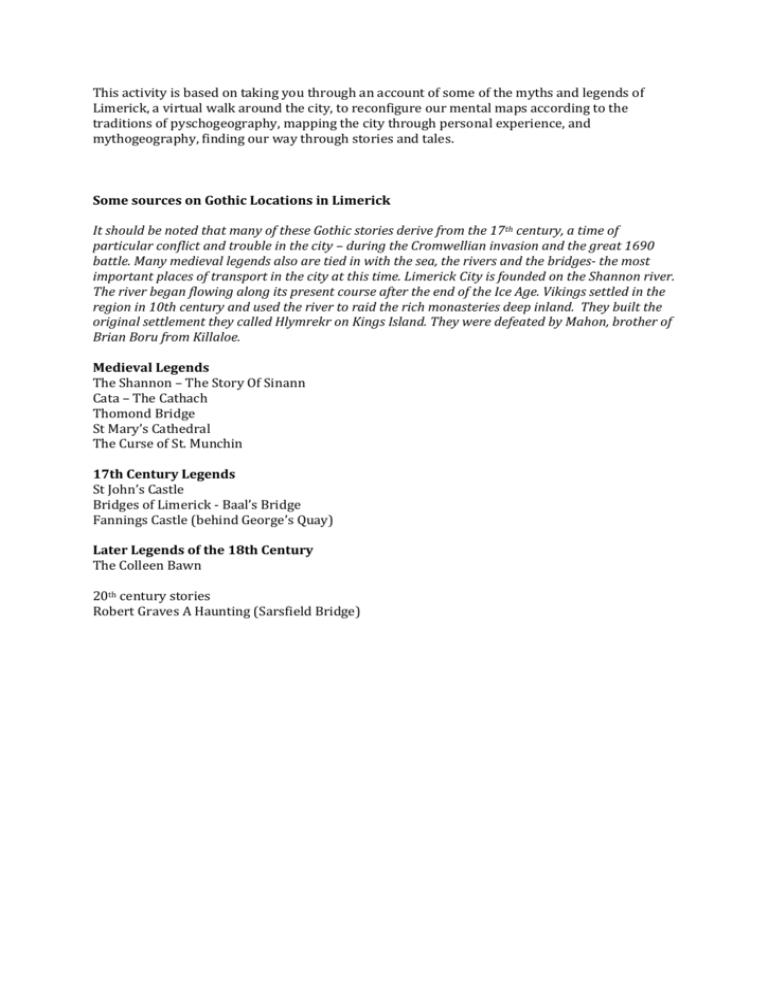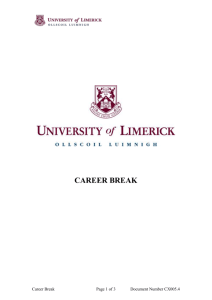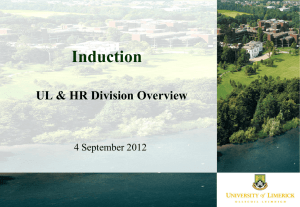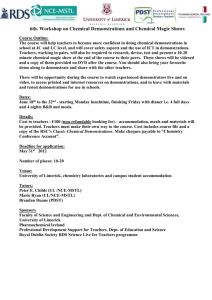This activity is based on taking you through an account of some of
advertisement

This activity is based on taking you through an account of some of the myths and legends of Limerick, a virtual walk around the city, to reconfigure our mental maps according to the traditions of pyschogeography, mapping the city through personal experience, and mythogeography, finding our way through stories and tales. Some sources on Gothic Locations in Limerick It should be noted that many of these Gothic stories derive from the 17th century, a time of particular conflict and trouble in the city – during the Cromwellian invasion and the great 1690 battle. Many medieval legends also are tied in with the sea, the rivers and the bridges- the most important places of transport in the city at this time. Limerick City is founded on the Shannon river. The river began flowing along its present course after the end of the Ice Age. Vikings settled in the region in 10th century and used the river to raid the rich monasteries deep inland. They built the original settlement they called Hlymrekr on Kings Island. They were defeated by Mahon, brother of Brian Boru from Killaloe. Medieval Legends The Shannon – The Story Of Sinann Cata – The Cathach Thomond Bridge St Mary’s Cathedral The Curse of St. Munchin 17th Century Legends St John’s Castle Bridges of Limerick - Baal’s Bridge Fannings Castle (behind George’s Quay) Later Legends of the 18th Century The Colleen Bawn 20th century stories Robert Graves A Haunting (Sarsfield Bridge) STOPS ON ROUTE ROUTE CLARE STREET THE GOOD SHEPHERD CONVENT This School stands on a medieval execution site of Farancroghy, a former Lancastrian school, a centre for the making of Limerick Lace and also of course the Good Shepherd Convent which also incorporated a Magdalen Laundry and an orphanage. The city of Limerick itself was established by Vikings settled in the region in 10th century and used the river to raid the rich monasteries deep inland. They built the original settlement they called Hlymrekr on Kings Island They were defeated by Mahon, brother of Brian Boru from Killaloe. BRIDGES OF LIMERICK - BAAL’S BRIDGE From February to May 1642, there was a pogrom against Protestant English inhabitants of Limerick. Estimates vary how many, but it is various recorded that between 22 and 100 people were flung off Baal’s Bridge to drown or to be bludgeoned to death with stones if they made their way to shore. The story of The Brazen Head is also attached to Baal’s Bridge. In 1690, the soldiers of William III came to Limerick and fought a battle on Baal’s bridge on the Abbey River. They were amazed by the men and women from the city who fought them back, long and hard. The Williamites eventually captured one of the Limerick women, a red-headed 20-year old girl and publicly beheaded her as a lesson to the citizens of Limerick. However, according to legend, after being beheaded and pikes, her decapitated head smiled serenely over the battlefield and inspired the people of Limerick to keep fighting. The soldiers christened her ‘the Brazen Head’ . FANNINGS CASTLE (behind George’s Quay) The remnants of the last remaining tower house in Limerick city is that of Fanning’s castle, which is situated just off Mary Street. Although it is Fanning’s Castle in name it was not in fact a castle but a late medieval fortified tower house. Dominic Fanning, a former mayor of the city, reputedly built the tower for himself in approximately 1641. During the Cromwellian Siege of 1651, the city seceded to Ireton. Fanning hid in the family vault in the graveyard of St. Francis’ Church in the Abbey. He was betrayed by a servant and hanged drawn and quartered. ST MARY’S CATHEDRAL There is a story attached to the cathedral of an Italian designer of bells, the finest of which were then stolen. According to the story, the designer travelled around the world, hoping to find them. Whilst sailing up the river Shannon into Limerick, he heard his bells ring from St. Mary’s and died of joy. In 1554 Edmond Sexton died and was secretly removed from his tomb in St. Mary’s Cathedral by his brother-in-law, Alderman Christopher Creagh, and the organist, David White. The right arm of the corpse was cut off and left in the tomb, the rest of the body was hung by the ankles above the ceiling of the chancel. The missing body was noticed during the burial of Sexton;s wife three years later, but the body itself was only discovered until a thief on the run found it. (Source – “A trusty and well-beloved servant”: the career and disinterment of Edmond Sexton of Limerick d. 1554) THE SHANNON – THE STORY OF SINANN Firstly, the Shannon is named after ‘Sinann’ who was a goddess in ancient Celtic mythology. She was the granddaughter of the sea king Lir (story – the Children of Lir) and embarked on a quest for the Well of Knowledge or Connla’s Well. A source of inspiration and knowledge in early Irish mythology, comparable to the well of Mimir in Norse tradition. The location of the well changes from text to text, and the identity of the Connla for whom it is named is not clear. It may be under the sea, in Tír na nÓg, the doorway to which is housed according to some myths in Lough Gur, which is also said to be built on ley-lines. Over the well, whatever its location, were nine hazel trees whose nuts contained wisdom, knowledge, and inspiration. The nuts dropped into the well, and the salmon swimming in it ate the nuts. The number of spots on each salmon indicated how many nuts it had eaten. Wisdom, knowledge, and inspiration came to the person who drank the water of the well or ate the salmon or the nuts. Because Sinann had neglected to observe the correct protocols, the well rose up and drowned her, creating a path to the sea that became the river itself. CATA – THE CATHACH Another, even more interesting story about Sinann said that she was a slayer of sea monsters. This tale brings us to the mouth of the Shannon itself. Sinann had a temple/sanctuary on the island of Inis-Cathaig or Scattery Island. The old Irish name for Scattery Island was Inis Cathaigh, after the Cathach or Péist - a legendary monster who inhabited the island and terrorised people. The first official mention of this Peist or Cata is in the Book of Lismore,an Irish vellum manuscript, compiled in early 15th century, Lismore, Ireland. The manuscript was compiled from the early, and lost, Book of Monasterboice as well as other manuscripts. The Book of Lismore contains a variation of themes. Part of the book references the lives of Irish saints, notably, St Brigid, St Patrick, and St Columba. Sinann’s story later translates as the story of St. Senan, a man, who killed a sea monster and established a monastery on Inis-Cathaigh; a monastery so strict and austere site that St. Senan forbade any woman living on or landing on the island. When St. Senan arrived on the island the Archangel Michael led him to the highest hill from which Senan was able to locate the Cathach. Senan faced the monster and ordered it to depart from the island. In some stories the Cathach obeyed immediately and 'neither stopped nor stayed' until he reached the dark waters of Doolough Lake at the foot of Mount Callan. T.J. Westropp relates how the Cathach devoured St. Senan's smith, Narach, but Senan brought him forth again alive. The Cathach advanced 'its eyes flashing flame, with fiery breath, spitting venom and opening its horrible jaws', but Senan made the sign of the cross, and the beast collapsed and was chained and thrown into Doolough Lake. "Hideous, uncouth, awful was the beast that arose there...a horse's mane had it; an eye gleaming, flaming in its head, angry, bounding..." Letter to Limerick Chronicle (1869) – written by someone who claimed to see a monster with a mane in Milltown Malbay. In Kilkee on September the 19th 1871 “An extraordinary monster...had an enormous head shaped somewhat like a horse...huge mane of seaweed looking hair...The eyes were large and glaring” (Source: Limerick Chronicle 1871) In 1922, from a letter written from a schooner owner and ship’s master Captain Hugh Shaw to a Mr. E. A. Aldridge of Gloucestershire “It was mistaken for a submarine and then it was seen to have motion of limbs: It was alive! And both banks of the river were thronged with people staring in awe: It was a living creature, and near enough to devour ten of them in one morsel.” (Main source: The Monster of Shannon Waves: A True Story by Shane Mac Olon. Other sources: the Limerick Leader and the Limerick Chronicle) ST JOHN’S CASTLE Established by the Normans, who stamped their shape on the emerging city, with the establishment of the Castle, the consolidation of the walled city and the division of the city into Englishtown and Irishtown. The castle had a hard time in the 17th century – with three sieges disrupting life in the city. Cromwellian War (1650-51) – Shannon acted as a marker – ‘To hell or to Connaught’ Jacobite/Williamite War (1690) and (1691) when the city finally surrendered. The city motto, carved on the nearby Treaty Stone, is well earned – Urbs antique fuit studiisque asperrima belli’ – ‘It was an ancient city hardened in the pursuits of war’ In the 17th century, the Shannon was of major strategic importance in military campaign in Ireland, as it formed a physical boundary between the east and west of the country. In the Irish Confederate Wars of 1641-53, the Irish retreated behind the Shannon in 1650 and held out for two further years against English Parliamentarian forces. In preparing a land settlement, or plantation after his conquest of Ireland Oliver Cromwell reputedly said the remaining Irish landowners would go to "Hell or Connacht", referring to their choice of forced migration west across the river Shannon, or death, thus freeing up the eastern landholdings for the incoming English settlers. In the Williamite war in Ireland (1689–91), the Jacobites also retreated behind the Shannon after their defeat at the Battle of the Boyne in 1690. Athlone and Limerick, cities commanding bridges over the river, saw bloody sieges. (See Sieges of Limerick and Siege of Athlone). THOMOND BRIDGE At King John’s Bridge, there are indentations on the top of the parapet. (source: A McLoughlin, Streets of Ireland) These are attached to the story of Drunken Thady and the Bishops’s Lady A Bishop’s wife who was so fond of drink, and men, and gambling, and cavorting and flaunting her position and her wealth that when she died, God had her sent back to Limerick to teach others that were like her the error of their ways. This she did by scaring the bejesus of anyone that has taken the demon drink that night and crossed her path. “He saw her face, grim large and pale Her red eyes sparkled through her veil, She would scare them into immobility and then fling them into the icy cold waters of the Shannon. “tis true she lived – tis true she died. Tis true she was a bishop’s bride: But for herself ‘tis little matter To whom she had been wife or daughter: Whether of Bradys or O’Gradys! She lived, like most ungodly ladies; Spending his reverend Lordship’s treasures Chasing the world’s evil pleasures…” “Every night she roamed with airy feet From Thomond bridge to Castle street And those that stayed out past eleven Would want a special guard from heaven She knocked two drunken soldiers dead, Two more with battered foreheads fled She broke the sentry box in staves And dashed the fragments in the waves! She slashed the gunners, left and right, And put the garrison to flight. (Michael Hogan “Drunken Thady and the Bishop’s lady”) It is said that she met her match in ‘Drunken Thady’ who for a bet, declared to his drinking companions that he would best her. They met and grappled and fought and scratched and screamed until finally his strength overpowered her and he threw her into the raging currents. She tried in vain to pull herself out but failed yet still she left her legacy for to this day, her handprint can still be seen on the bridge to this very day…….. THOMOND BRIDGE - THE CURSE OF ST MUNCHIN. It is reported that as St. Munchin was building the first church in Limerick, the workers had great difficulty in fixing a big stone into position. St Munchin asked many of the native citizens for help as they passed by, but all refused. Help came eventually from a group of strangers who came forth and fixed the stone into place. St. Munchin then cursed the people of Limerick saying that they would be unfortunate and unsuccessful and only strangers would prosper in the city. “May ye always want something to wear, And always want something to buy it, And always have nothing to share, And always have ways to supply it! THE SEA Ireland as an island nation has always had a deep relationship with sea-going, something that can be seen from historical accounts of the estuary and the path of the Shannon from Limerick outwards to sea. Four people from Askeaton sailed on the Titanic, two survived, two perished. THE COLLEN BAWN In 1820, Lieutanant John Scanlan went on trial for the murder of a teenage girl, Eileen Hanley whom he mock-married in a fake ceremony. She was later found drowned, washed up in the Shannon estuary. Despite being defended by barrister Daniel O’Connell, he was found guilty and hanged. The incident inspired Dion Boucicault’s play The Colleen Bawn as well as local writer Gerald Griffin’s novel, The Collegians. THE SEA AND LIMERICK – THE STORY OF THE SIR FRANCIS SPAIGHT Cannibalism occurred on the Sir Francis Spaight bound for Limerick in 1835. The ship has blown off-shore and rations had run low so the apprentice-boys were forced to draw straws to see who would be eaten. The victim was a 15 year old apprentice boy who lived with his mother in Thomondgate, Limerick. Later retold as a short story by Jack London (Source: Denis O’Shaughnessy) THE TREATY STONE Penal Laws enforced. The treaty really consisted of two treaties, both of which were signed on 3 October 1691. They were allegedly signed here on the Treaty Stone, an irregular block of limestone which once served as a mounting block for horses. These articles protected the rights of the defeated Irish Jacobite landed gentry, however according to legend "the ink was not dry on the Treaty" before it was broken—the civil articles were not honoured by the Williamite government. In 1695, as discussed in our Irish Gothic lecture, a series of harsh penal laws were enacted which severely limited the rights of Catholics.






